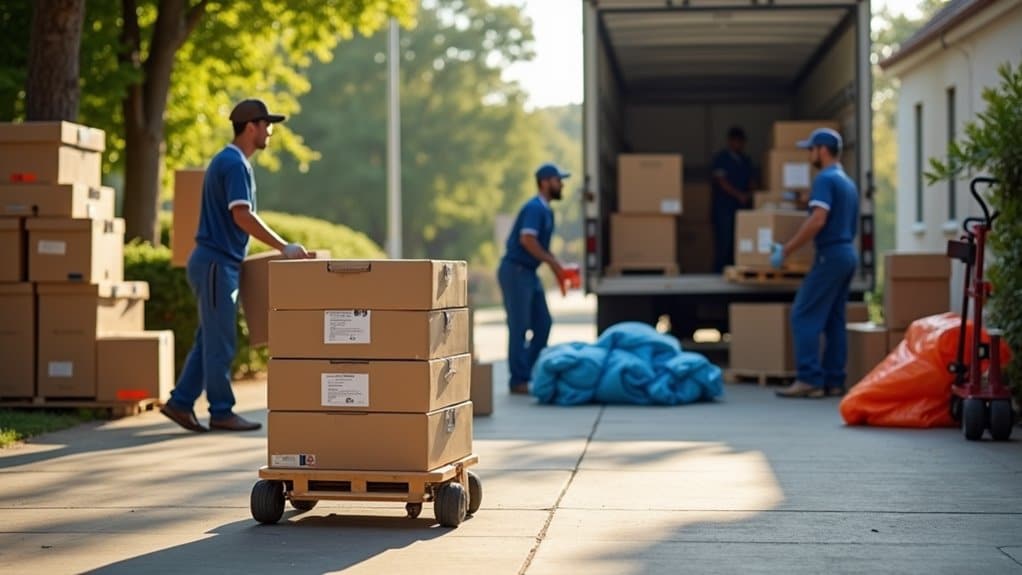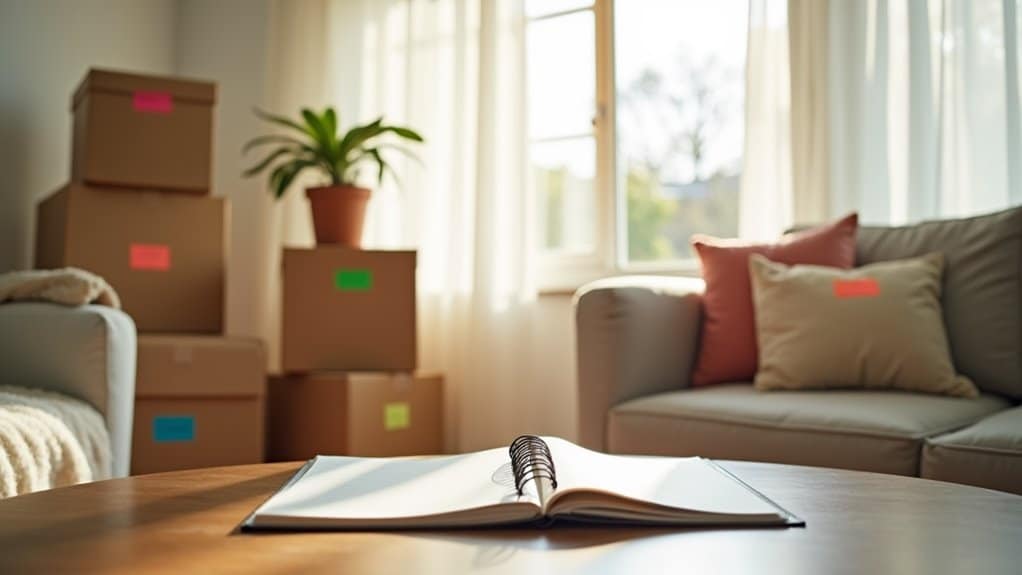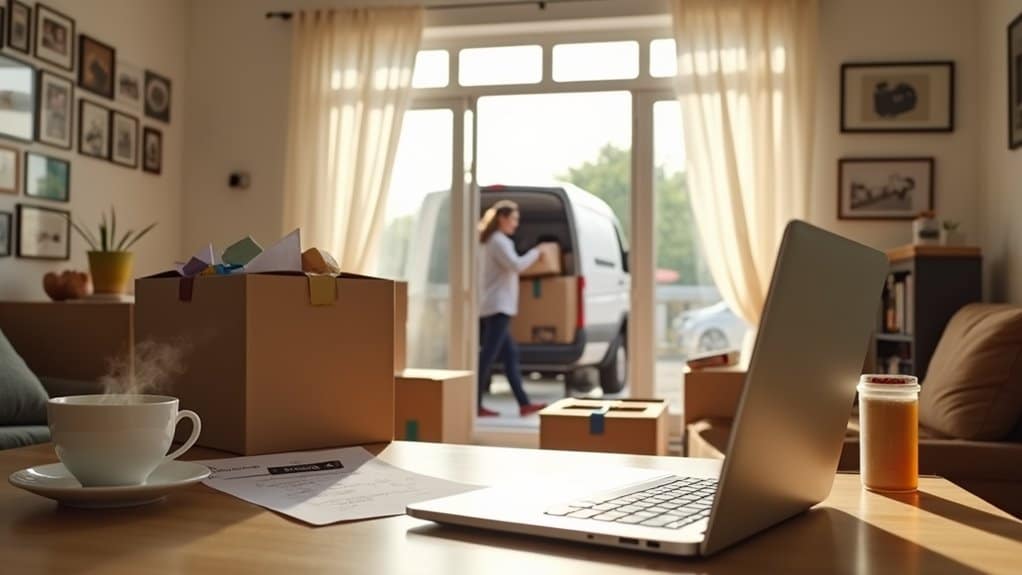
10 Steps to Stress-Free Local House Removals
To ensure a stress-free local house removal, begin with careful pre-move planning. Reach out to moving companies for quotes at least four weeks ahead of your move. Take the time to declutter your belongings and create an inventory list. Pack efficiently by organising room by room and clearly labelling your boxes. Choose dependable movers by checking their credentials and reviews. Book any necessary equipment early and confirm utility setups at your new home. Keep essentials handy for your first night, and take care of final details at your old address. By following these steps, you'll pave the way for a smooth transition into your new home, where more helpful tips await!
Key Takeaways
- Begin planning at least 4 weeks ahead by researching and booking reputable removal companies for quotes and availability.
- Declutter your belongings 3 weeks before the move. Sort items into 'keep', 'donate', and 'discard' piles to reduce what needs packing.
- Create a comprehensive inventory of all items for tracking and insurance purposes, ensuring nothing goes missing during the move.
- Pack systematically by room and label boxes clearly, prioritising essential items for easy access when you arrive at your new home.
- Confirm that all utilities are connected and operational before moving in, to ensure a hassle-free transition into your new space.
Pre-Move Planning
How can you ensure a smooth transition to your new home? Pre-move planning is essential. Start by reaching out to moving companies four weeks before your move. Request quotes and book your preferred service early to secure your date.
Three weeks prior, declutter your belongings by sorting them into three categories: keep, donate, and discard. This will lighten your load and simplify the move. Creating an inventory list will also help you keep track of what you're taking with you; this is important for ensuring that everything is accounted for during the move and can help facilitate any insurance verification if needed.
Two weeks before the move, focus on organising your documents. Collect all essential paperwork related to your move, such as quotes and receipts, and store them in a digital folder for easy access on moving day. Additionally, having cash set aside for last-minute expenses can help you manage unexpected costs.
Remember to update your address with the post office, banks, and utility providers.
One week before the move, confirm all arrangements with the moving team. Clear pathways around your home to ensure easy access for the moving lorry; this aligns with efficient moving practices that minimize complications on the day of the move.
Effective Packing Strategies
Here's your revised article subheading content with the requested modifications:
—
With your pre-move planning sorted, it's time to tackle the packing process efficiently. Focus on strategic packing to ensure a smooth transition. Start by gathering your packing materials and moving supplies. It's essential to use the right packing materials to protect your items effectively.
Use decluttering techniques to sift through your belongings and reduce what you'll take with you.
Here's a straightforward checklist to follow:
- Pack Room by Room: Start with the least-used rooms to make the process easier.
- Protect Fragile Items: Wrap delicate belongings in bubble wrap or similar protective materials.
- Label Boxes Clearly: Mark each box with its contents and the room it belongs to for hassle-free unpacking.
- Maximise Space: Fill bags and bins with smaller items to make the most of your packing space. Additionally, consider packing supplies that can help safeguard your items during the move.
Consider DIY packing tricks, such as using socks to cushion fragile glassware or bin liners for hanging clothes.
Also, create a box for essentials—items you'll need immediately upon arrival.
—
Let me know if you need any further adjustments!
Organizing Logistics and Equipment

When planning your move, it's crucial to book moving equipment well in advance to ensure you have the necessary tools ready. Confirm your travel arrangements promptly to prevent any last-minute complications that could disrupt your plans. Additionally, considering that moving services are tailored to local moves, this can help streamline the process and reduce stress during your relocation. A panel van is often the ideal choice for small to medium-sized moves due to its versatile load space dimensions.
Reserve Moving Equipment Early
Reserve Moving Equipment Early
Securing the right moving equipment in advance can significantly reduce stress during your house move. By planning early and using effective reservation software, you can ensure you have the necessary tools ready. Here are some essential tips:
- Assess Equipment Needs: Determine the types of equipment you'll need based on your moving plan.
- Use Reservation Software: Take advantage of software to manage real-time bookings and check availability.
- Plan Ahead: Schedule your equipment use to avoid conflicts and ensure everything runs smoothly.
- Monitor Availability: Keep an eye on your reservations to prevent double bookings or cancellations. Additionally, be sure to execute a search for reservations to check equipment availability before making your booking.
Consider starting with soft reservations for more flexibility. If you know you need specific equipment, you can convert these to hard reservations once availability is confirmed.
Always check the status of your preferred equipment before finalising your booking. By following these steps, you'll streamline your logistics and minimise the risk of last-minute surprises.
Confirm Travel Arrangements Efficiently
Efficient travel arrangements are crucial on moving day to ensure everything runs smoothly. Start by planning your travel routes. Identify the quickest paths to avoid traffic and unnecessary delays. If you're moving in a busy area, obtain parking permits in advance to secure available spots. Also, check access points, like lifts or loading bays, to facilitate the moving process.
Next, outline your move clearly. A well-structured plan will aid with heavy lifting and logistics. Be sure to check for roadworks or closures that might impact your journey. Seasonal timing and weather conditions can also affect travel arrangements, so consider these factors when planning your move.
Coordinating utilities is just as vital. Schedule transfers and cancellations to align with your moving day. Confirm that all utilities are activated in your new home and notify service providers of your address change. Ensure disconnections are arranged for your old place, and double-check service dates to prevent any interruptions.
Finally, go over all moving details with your removal company. Conduct a last-minute inspection to ensure nothing is left behind, secure your old home, and document everything. With these arrangements sorted, you'll be well-prepared for a hassle-free move.
Choosing Professional Movers
When selecting professional movers, it's important to research moving companies carefully.
Check their licences, certifications, and customer reviews to ensure you're making a well-informed choice.
For instance, if you need specialist services like piano removal or packing assistance, confirm that the company offers these options to suit your specific requirements.
Research Moving Companies
Thorough research into moving companies is crucial for ensuring a smooth transition to your new home.
Start by verifying each company's credentials. Look for important details such as their licenses, physical addresses, and industry accreditations. This will help you weed out any illegitimate businesses.
Next, check the reputation of the movers. Read online reviews and customer testimonials to gauge satisfaction levels. Recommendations from friends or family can also provide valuable insights.
Keep these key points in mind during your research:
- Verify Company Credentials: Ensure they possess the necessary licences and have a physical address.
- Check Reviews: Look for customer testimonials to understand their experiences.
- Get Multiple Estimates: Request detailed, written quotes to accurately compare costs.
- Confirm Moving Insurance: Ensure the company offers insurance that covers your belongings.
Evaluate Service Options
Choosing the right professional movers requires assessing various service options to ensure they suit your needs.
Start by reviewing the range of moving services available. Ensure they offer essential services like packing, loading, and transport, as well as specialised options such as custom crating or vehicle transportation. Don't overlook their equipment and supplies, like boxes and protective blankets.
Next, check the company's credentials. Look for a valid physical address and confirm they've the necessary licenses, such as a UK operator licence. Accreditations from organisations like the British Association of Removers can also indicate a commitment to quality service.
When it comes to pricing, obtain multiple quotes to compare. Be mindful of any hidden fees and clarify their policies on damage valuation.
Finally, assess the company's reliability. Look out for warning signs such as tardiness or unprofessional conduct. Research customer reviews to understand their reputation and ask about their customer support.
Preparing Your New Home

Preparing your new home involves several key steps to ensure a smooth transition. By setting up utilities, conducting maintenance checks, and prioritising safety, you can create a welcoming environment before moving in.
Here are the essential actions to take:
- Utilities Setup: Ensure that electricity, water, and gas are operational before your move. Double-check that all services are functioning correctly.
- Home Maintenance and Inspections: Assess the roof, check appliances, and replace batteries in smoke and carbon monoxide detectors. Create seasonal maintenance checklists to keep on top of things.
- Cleaning and Organisation: Either book a cleaning service or plan to tackle it yourself. Prepare an essentials box for immediate needs and label your boxes for easier unpacking.
- Safety and Security: Change the locks on exterior doors, note the locations of utility shut-off valves, and develop an emergency response plan. Inspect any home security devices to ensure they're working effectively.
Tips for Moving Day
On moving day, starting early is crucial for a smooth experience, so don't underestimate the benefits of an early start.
Ensure your essential items are organised and easily accessible to make your first night in the new home comfortable.
Finally, do a final walk-through of your old property to ensure you haven't left anything behind, giving you peace of mind as you settle in.
Start Early Preparation
Starting your preparation early can make a considerable difference on moving day. A proactive approach helps reduce stress and ensures everything runs smoothly.
Here are some essential tips to get your preparation underway:
- Create a Detailed Moving Checklist: Break tasks into manageable steps to stay organised.
- Set a Realistic Timeline: Assign specific days for each task to avoid last-minute rushes.
- Inform Relevant Parties: Notify utility providers, banks, and other key organisations ahead of time.
- Book Equipment and Services Early: Reserve removal vans and packing materials in advance to prevent availability issues.
Organize Essential Items
Once you've completed your early preparations, it's time to organise the essential items you'll need on moving day.
Start by creating an essentials box that contains everything you'll require for the first 24-48 hours. This should include toiletries such as your toothbrush, toothpaste, shampoo, soap, and toilet paper. Don't forget your medications and a basic first-aid kit. Pack a change of clothes and keep important documents like IDs and financial papers close at hand.
Label your boxes clearly with colour-coded labels or a numbering system to identify their contents and the rooms they belong to. Create an inventory list to track items by category and room, ensuring easy unpacking and quick access when you arrive.
Assign tasks to family members or movers to streamline the process and maintain open communication throughout the day.
Prepare moving in and out cartons with tools like a screwdriver, utility knife, and some snacks. Finally, keep your cleaning supplies accessible for any last-minute touch-ups.
Organising these essential items will help ensure a smoother moving day and reduce stress as you transition to your new home.
Final Walk-Through Check
A final walk-through is a crucial step before you officially take possession of your new home. This inspection ensures that the property's condition meets your expectations and confirms that all repairs agreed upon after the home inspection have been completed. Schedule this walk-through for the day before or on the day of completion to catch any last-minute issues.
Here are some tips to prepare for your final walk-through:
- Review the home inspection report to check that all repairs have been made.
- Gather necessary documents, such as the purchase agreement and any repair amendments.
- Inspect all rooms and systems, including heating, ventilation, and plumbing.
- Document any discrepancies you may find during the inspection.
During the walk-through, check every room, including the loft and cellar, and ensure that all agreed items are present. If you encounter any issues, inform the seller immediately.
You may need to negotiate repairs or compensation before completion. It's essential to keep all agreements documented to safeguard your investment.
This step helps ensure a smooth transition to your new home, allowing you to move in with confidence.
Managing Utilities Setup

Managing utility setups for your new home can be straightforward if you stay organised. Start by listing the essential utilities you'll need: electricity, gas, water, internet, TV, and waste collection.
Research local providers to compare services and find the best options that suit your budget. Remember to check what utilities are covered in your tenancy agreement or any homeowners' association (HOA) contracts.
Once you've selected your providers, arrange the utility connections well in advance, particularly during busy moving periods.
Create a simple checklist with provider names, start dates, and account numbers to keep track.
Don't forget to inform your current utility companies about your move and schedule disconnections for your last day of service.
Make sure to settle any outstanding balances and request final meter readings.
On moving day, take final meter readings and keep a record.
After your move, check in with your new providers to confirm that everything is set up before you arrive.
With careful planning and timely communication, transitioning to your new home can be smooth and hassle-free.
Keeping Essentials Handy
Keeping Essentials Handy When Moving****
When moving, it's crucial to keep your essentials close at hand to ease the transition to your new home. Prioritising what you need can ensure that everything is readily accessible during the move.
To make your relocation smoother, pack an overnight bag with these essentials:
- Basic Supplies and Tools: Include tape, a box cutter, and a first-aid kit.
- Morning Routine and Food: Don't forget your kettle, some non-perishable snacks, and bottled water.
- Personal and Pet Care: Pack your toiletries, any necessary medications, and bedding for your pets.
- Emergency and Comfort Items: A torch, phone charger, and some entertainment like books or magazines.
Having these items easily reachable will help you settle in quickly and minimise stress. The last thing you want is to sift through boxes for your toothbrush or kettle on your first morning in your new place.
Finalizing Old Home Details

Packing your overnight bag and keeping essentials handy sets the stage for your next steps. Before you officially close on your old home, it's important to finalise all details for a smooth transition.
Start by obtaining final mortgage approval from your underwriters. Carefully review your financial documents to ensure they're accurate and reflect any recent changes in your loan estimate. Keep a copy of the approval accessible from your estate agent or mortgage broker.
Next, carry out a final property inspection 24 to 48 hours before closing. This walk-through allows you to confirm that all agreed repairs are completed and that plumbing and electrical systems are working properly.
Test the appliances included in the sale and check every room, including cupboards and loft spaces, for any issues that may have been overlooked.
Finally, ensure all utilities—water, electricity, and gas—are operational. Check safety features like smoke detectors and fire extinguishers.
With your closing appointment confirmed and all documents gathered—including proof of home insurance—you'll be ready to sign and hand over the keys with confidence.
Settling Into Your New Space
Settling into your new space can be daunting, but with a clear plan, you can make the transition smoother. Start by unpacking the essentials—think bedding, toiletries, and kitchenware—to ensure you have what you need right away.
Arrange your furniture in familiar layouts to help you feel at home more quickly. As you get settled, take time to explore your new neighbourhood and connect with the local community.
Here are some straightforward tips to help you settle in:
- Unpack Essentials First: Prioritise items like bedding and kitchen essentials to get your day-to-day life up and running.
- Familiarise Yourself with Local Amenities: Find nearby shops, parks, and eateries to get a sense of your new surroundings.
- Engage with Your Community: Consider joining local clubs or volunteering to meet new people and build connections.
- Establish Daily Routines: Create a schedule for meals and activities to add stability to your new life.
As you unpack and make the space your own, address any issues as they arise to keep stress at bay.
Frequently Asked Questions
How Do I Choose the Best Moving Date?
Did you know that 70% of people prefer moving in summer? For the best moving date, consider aiming for September. This month typically offers milder weather, helping you avoid extreme temperatures and making your move smoother.
What Should I Do With Perishable Food Items?
Assess your perishable food items, prioritise them, and plan meals to use them up effectively. For items you can't consume, consider donating to local food banks or charities. This approach helps reduce waste and keeps everything organised. For example, if you have ripe bananas, you could make banana bread or smoothies.
Can I Move My Plants to the New Home?
Did you know that 80% of plant owners take their plants with them when they move? You can absolutely bring your plants to your new home! Just follow some basic care and moving tips to ensure they thrive during the transition.
How to Handle Parking Permits for Moving Trucks?
To manage parking permits for moving trucks, first check your local parking regulations. Submit your permit application well in advance. Include clear details about your move, such as the date and duration, to avoid any delays. It's also wise to arrange for "No Parking" signs to ensure a hassle-free loading and unloading process. For example, if you're moving in London, local councils may require you to book a bay for your truck, so plan accordingly.
What if I Accidentally Damage Something During the Move?
If you accidentally damage something during the move, stay calm. First, assess the damage and take photos for documentation. Then, check your insurance options to see if you're covered. For future moves, focus on prevention – using proper packing materials and securing items can help ensure a smoother, stress-free experience.
Conclusion
Follow these 10 steps to make your house removal a smooth and stress-free experience. From planning well in advance to settling into your new home, each step is crucial for a successful move. Taking the time to prepare can save you from chaos on the big day. Remember, with proper planning and the right support, you're not just relocating; you're starting a new chapter in a place you'll truly enjoy calling home.


